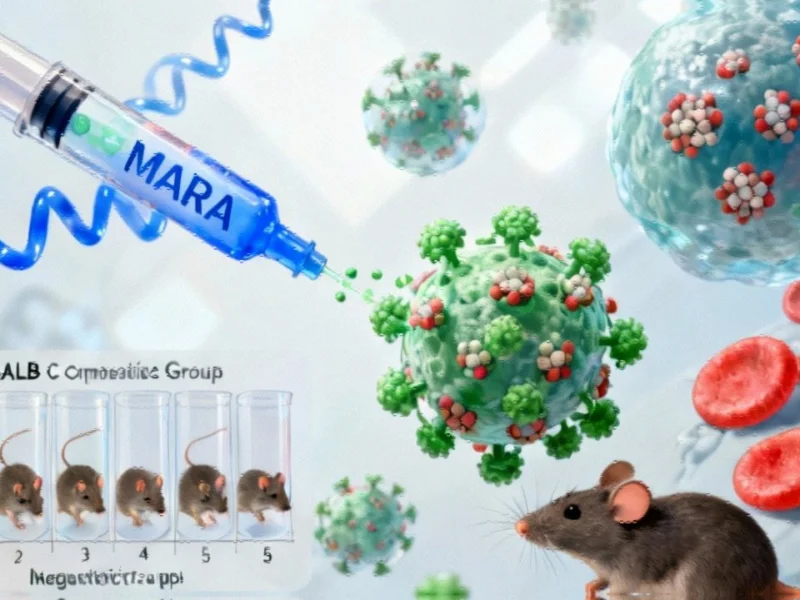Breakthrough Vaccine Technology Combines mRNA Speed with Protein Nanoparticle Precision
A revolutionary vaccine platform that merges messenger RNA technology with computationally designed protein nanoparticles has demonstrated remarkable effectiveness against multiple SARS-CoV-2 variants in preclinical studies. University of Washington researchers, collaborating with multiple institutions, have engineered a novel approach that generates significantly stronger immune responses than current mRNA vaccines while maintaining the rapid production advantages that made mRNA vaccines so valuable during the pandemic.
The Science Behind the Innovation
The research team genetically fused a stabilized SARS-CoV-2 receptor binding domain variant called Rpk9 to a computationally optimized 60-subunit scaffold nanoparticle designated I3-01NS. This approach represents a significant advancement in vaccine design methodology that could transform how we respond to emerging pathogens. Unlike traditional vaccines that primarily stimulate antibody production, this platform triggers both robust antibody and T cell responses, creating a more comprehensive immune defense.
As the researchers detailed in their Science Translational Medicine publication, the integration of protein nanoparticle immunogens with mRNA delivery creates a synergistic effect. The nanoparticles display multiple antigen copies in precise arrays, which amplifies antibody responses by clustering B cell receptors. This combination addresses one of the key limitations of first-generation mRNA vaccines while preserving their manufacturing scalability.
Superior Performance in Preclinical Models
In BALB/c mouse models, the mRNA-launched RBD nanoparticles dramatically outperformed comparator mRNA vaccines. The single-dose Wuhan-Hu-1 arm showed that Rpk9-I3-01NS mRNA elicited approximately 28 times higher titers than membrane-anchored S-2P mRNA and about 11 times higher than secreted RBD-trimer mRNA. Even at the lowest mRNA dose tested, responses were comparable to or greater than those achieved with substantially higher doses of standard spike-encoding formulations.
The vaccine platform’s effectiveness extended beyond initial immune response measurements. Single-dose vaccination completely protected mice from lethal challenge with mouse-adapted Wuhan-Hu-1 SARS-CoV-2, preventing weight loss and eliminating detectable virus in lung tissue. Two-dose immunization blocked severe disease after omicron BA.5 challenge, suppressing viral replication in respiratory tissue and preserving body weight throughout observation periods.
Cellular Immunity: A Critical Advantage
Perhaps most notably, C57BL/6 mice receiving the nanoparticle mRNA displayed abundant antigen-specific CD8 T cells in both lungs and spleen—a response that protein-delivered counterparts failed to elicit. This indicates the mRNA platform uniquely engages cellular immunity, which is crucial for long-term protection and viral clearance. The presence of these T cells in respiratory tissue is particularly valuable for preventing severe disease.
This breakthrough comes amid broader industry developments in biotechnology and vaccine platforms that are pushing the boundaries of medical science. The integration of computational design with biological delivery systems represents a growing trend in pharmaceutical innovation.
Cross-Reactive Protection and Manufacturing Implications
Serum analyses following booster vaccinations showed persistent neutralization against the original Wuhan-Hu-1 strain while additional assays demonstrated cross-reactivity to omicron BA.5. This broad protection suggests the platform could be particularly valuable against rapidly evolving viruses where variant-specific responses are essential.
The manufacturing implications are equally significant. The researchers present mRNA-launched protein nanoparticle immunogens as a way to combine multivalent antigen display with nucleic acid manufacturing speed. Their I3-01NS results serve as a proof of concept for a genetically deliverable, computationally designed scaffold that could be adapted across multiple pathogens when paired with appropriately engineered antigens.
This innovation aligns with other recent technology advances across multiple sectors, demonstrating how computational approaches are transforming traditional industries. The ability to rapidly design and produce effective vaccines could dramatically improve our preparedness for future pandemics.
Broader Industry Context and Future Applications
The successful integration of computational protein design with mRNA delivery platforms represents a significant milestone in vaccine development. As researchers continue to refine this approach, the potential applications extend beyond COVID-19 to other infectious diseases, cancer vaccines, and therapeutic proteins.
This advancement in biological engineering coincides with progress in other technical fields, including related innovations in computing architecture and semiconductor technology that enable more sophisticated computational design work. The convergence of these disciplines is accelerating the pace of medical discovery.
Similarly, strategic moves in the industrial sector, such as market trends toward specialization and focus, mirror the targeted approach these researchers have taken with vaccine design. The successful application of computational methods to biological problems suggests new opportunities for cross-disciplinary collaboration.
Global Research Landscape and Implementation Challenges
The development of this platform occurs against a backdrop of increasing international scientific competition and collaboration. Research institutions worldwide are racing to develop next-generation vaccine technologies, with particular focus on platforms that offer both speed and breadth of protection. This global effort reflects the lessons learned from the COVID-19 pandemic about the importance of flexible, scalable vaccine technologies.
Meanwhile, the implementation of advanced medical technologies faces various challenges, as seen in industry developments involving regulatory approvals and international partnerships. These dynamics will likely influence how quickly this new vaccine platform can transition from laboratory success to clinical application.
The research community continues to make strides in specialized fields, with institutions like recent technology centers advancing regional capabilities in scientific innovation. Such developments contribute to a more distributed global research ecosystem that can respond more effectively to health threats.
At the same time, investments in technological infrastructure, such as market trends toward digital transformation in industrial regions, create environments more conducive to advanced research and development. These parallel developments in research capacity and technological infrastructure will be crucial for translating laboratory breakthroughs into practical solutions.
Conclusion: A New Paradigm in Vaccine Development
This mRNA-nanoparticle hybrid platform represents a significant evolution in vaccine technology that addresses key limitations of previous approaches. By combining the rapid development and manufacturing advantages of mRNA with the enhanced immunogenicity of computationally designed protein nanoparticles, researchers have created a versatile platform with potential applications far beyond the current pandemic.
The demonstrated protection against multiple variants, strong T cell responses, and dose-sparing effects suggest this approach could become a new standard for vaccine development against evolving pathogens. As the platform advances toward clinical testing, it offers hope for more effective and adaptable responses to future infectious disease threats.
This article aggregates information from publicly available sources. All trademarks and copyrights belong to their respective owners.

